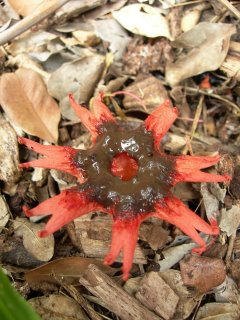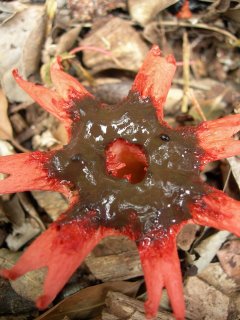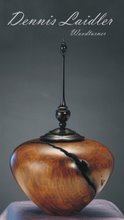
This morning Gigi and I led a 'tree walk' in Kirstenbosch National Botanic Garden to introduce members of the Western Cape Woodturning Association to some of our local trees. We stopped near the site of an old farmstead - you can see an Apple tree in full bloom behind the group

While showing the group a couple of old Spanish Chestnut trees we spotted a couple of pill bugs (Isopods). The spiky things around the pill bugs are the remains of the chestnut seed pods

Andi photographing pill bugs too

Taking a short snack break on the viewing platform

Restios - a type of Western Cape endemic reed

On the forest floor we found this interesting specimen ...
This is the fruiting body of a fungus called Aseroe rubra.
It's apparently fungus from Australia - another Australian invasive in South Africa - enough already!
The 'chocolate' is foul smelling spore slime that attracts insects who then crawl/fly off and spread the spores.

Here you can see a couple of bugs crawling around in the spore slime
The common name is a stinkhorn

A side view of Aseroa rubra

Introducing more trees - there are also many other interesting biological phenomena in the forest as you can gather from the pics in this post

Andi didn't think much of the seeds of the Turkey Berry (Cantheum inerme).
In Africaans the tree is known as 'Gewone Bokdrol' - literally translated 'Ordinary Goat droppings' after the appearance of the seeds

Here is Andi giving her professional opionion of the aesthetic merits of the Turkey Berry seeds

A spotted eagle owl sitting in a wild olive tree

The group watching the owl

Another view of the owl - AHV
A crazy ornithologist that I know delivered a scientific paper at a congress, commenting on numerous bird observations as AHV. During the question time one brave scientist decided to bare his ignorance and asked the meaning of AHV. The ornithologist explained that many of the observations were of birds rapidly flying away from him - Arse Hole View of course!

Andi chatting to the group about a couple of Hyobanche specimens that we visited. This is the group of plants that she studies and is the reason for her annual trips to South Africa - other than woodturning!

This is the Hyobanche sanguinea that was hiding under the bushes (Chrysanthemoides sp.) that Frank Maunder was pearing into in the previous picture. Hyobanche is a root parasite that grows primarily on the roots of Chrysanthemoides sp. as well as a few other species
This 'flower' is actually and inflorescence (and here) composed of numerous bracts and florets rather than being a flower in the true sense of the word

The Kirstenbosch Research Centre (left) and the Rufford Maurice Laing Centre for Biodiversity Conservation (right)

The cycad section just above the Dell

A beautiful Protea hybrid growing in Kirstenbosch

Showing the beautiful spiral arrangement of the florets that make up this inflorescence
Thanks to Gigi who took many of the above pics while I was talking 'trees' to the group.


1 comment:
Post a Comment